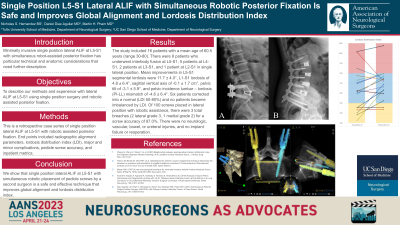Single Position L5-S1 Lateral ALIF with Simultaneous Robotic Posterior Fixation Is Safe and Improves Global Alignment and Lordosis Distribution Index
Friday, April 21, 2023


Nicholas S. Hernandez, BS (he/him/his)
Medical Student
Tufts University School of Medicine
Boston, Massachusetts, United States
ePoster Presenter(s)
Introduction: Minimally invasive lateral anterior lumbar interbody fusion (ALIF) at L5-S1 is a compelling approach to treat lumbar disease and improve lordosis. Single position lateral ALIF at L5-S1 with simultaneous robot-assisted posterior fixation has particular technical and anatomic considerations that need further description.
Methods: This is a retrospective case series of single position lateral ALIF at L5-S1 with robotic assisted posterior fixation. Cases of unilateral fixation, revision surgery, or those requiring repositioning were excluded. End points included radiographic alignment parameters, lordosis distribution index (LDI), major and minor complications, pedicle screw accuracy, and inpatient metrics.
Results: The study included 16 patients with a mean age of 60.5 years (range 30-80). Average follow-up was 8.3 months (range 2.0-25.6). All patients had ALIF-type cages implanted at L5-S1 through oblique lateral minimally invasive incisions. There were 8 patients who underwent interbody fusion at L5-S1, 5 patients at L4-S1, 2 patients at L3-S1, and 1 patient at L2-S1 in single lateral position. Mean improvements in L5-S1 segmental lordosis were 11.7 ± 4.0°, L1-S1 lordosis of 4.8 ± 6.4°, sagittal vertical axis of -0.1 ± 1.7 cm°, pelvic tilt of -3.1 ± 5.9°, and pelvic incidence lumbar – lordosis (PI-LL) mismatch of -4.6 ± 6.4°. Six patients improved from an LDI of hypolordotic (LDI < 50) or hyperlordotic (LDI>80) to normal (LDI 50-80); no preoperatively normal LDI patients become imbalanced. Of 94 screws placed in lateral position with robotic assistance, there were 3 total breaches (2 lateral grade 3, 1 medial grade 2) for a screw accuracy of 96.8%. There were no neurologic, vascular, bowel, or ureteral injuries, and no implant failure or reoperation.
Conclusion : We show that single position lateral ALIF at L5-S1 with simultaneous robotic placement of pedicle screws by a second surgeon is a safe and effective technique that improves global alignment and lordosis distribution index.
Methods: This is a retrospective case series of single position lateral ALIF at L5-S1 with robotic assisted posterior fixation. Cases of unilateral fixation, revision surgery, or those requiring repositioning were excluded. End points included radiographic alignment parameters, lordosis distribution index (LDI), major and minor complications, pedicle screw accuracy, and inpatient metrics.
Results: The study included 16 patients with a mean age of 60.5 years (range 30-80). Average follow-up was 8.3 months (range 2.0-25.6). All patients had ALIF-type cages implanted at L5-S1 through oblique lateral minimally invasive incisions. There were 8 patients who underwent interbody fusion at L5-S1, 5 patients at L4-S1, 2 patients at L3-S1, and 1 patient at L2-S1 in single lateral position. Mean improvements in L5-S1 segmental lordosis were 11.7 ± 4.0°, L1-S1 lordosis of 4.8 ± 6.4°, sagittal vertical axis of -0.1 ± 1.7 cm°, pelvic tilt of -3.1 ± 5.9°, and pelvic incidence lumbar – lordosis (PI-LL) mismatch of -4.6 ± 6.4°. Six patients improved from an LDI of hypolordotic (LDI < 50) or hyperlordotic (LDI>80) to normal (LDI 50-80); no preoperatively normal LDI patients become imbalanced. Of 94 screws placed in lateral position with robotic assistance, there were 3 total breaches (2 lateral grade 3, 1 medial grade 2) for a screw accuracy of 96.8%. There were no neurologic, vascular, bowel, or ureteral injuries, and no implant failure or reoperation.
Conclusion : We show that single position lateral ALIF at L5-S1 with simultaneous robotic placement of pedicle screws by a second surgeon is a safe and effective technique that improves global alignment and lordosis distribution index.
